UPES Online MBA
Apply for Online MBA from UPES
A well-crafted design portfolio is the most powerful tool for showcasing your creativity, skills, and professional identity in today’s competitive market. Whether you are a graphic designer, UI/UX specialist, or aspiring creative professional, your portfolio acts as a visual resume that highlights not only your technical abilities but also your design thinking and problem-solving approach. In 2025, employers and clients look for portfolios that are clean, impactful, and tailored to specific industries. In this article, we share six quick tips to build the best design portfolio that can help you stand out, attract opportunities, and grow your career.

To build a good design portfolio, it is important to keep in mind that your portfolio should tell a story. Weaving a story in your portfolio will show your creativity, understanding of the subject, and mastery of the skill you gained. To build a portfolio that will excel your career, check the quick tips below.
.png)
One of the most important tips for design portfolio is that you should focus on quality rather than quantity. Having 5-6 well-thought-out designs in the portfolio is important as it shows more creativity, versatility, and initiative to solve problems than 15 half-baked designs. It is important for Graphic Designers or designers from any field to be concise and to the point in their portfolio as it shows the high-order thinking skills of ideation and editing.
As a designer, it is important to know what your audience needs and show your work accordingly since your audience is your end consumer. Design portfolios should be curated concisely as per the job profile and client needs. Going through that one-size-fits-all portfolio will be time-consuming.
For Example: For a UX design role, emphasise projects that showcase user research, wireframes, and prototypes. For a branding project, highlight your creative process and final deliverables.
One of the best tips for design portfolio is to include the process of your work along with the final product. Your creativity, such as sketches, mockups, thought process, such as challenges faced, latest technology used in the design industry, such as Adobe Creative Suite, Sketch, Figma, or any other tools relevant to your work, and mindfulness, such as case studies and research analysis, in the portfolio will add a personal touch and will show your uniqueness. You can also add client testimonials.
In your design portfolio, keep a balance between the use of texts and visuals. It is important to keep your portfolio eye-catching. Keep the ratio from 50/50 to 25/75; a good balance of visuals and texts will help to weave a good story. A few points one should keep in mind to make this balance work:

Keep adding your new work, achievements, new skill you learnt, or anything important and relevant to your career in your design portfolio in a mannered way. It will help you avoid last-minute hassle while sharing your portfolio with your client or recruiters.
Design portfolios should be built strategically, adaptively, and creatively. Prioritise the quality, target your audience, expose your process, utilise technology, and maintain a current portfolio, and you are sure to develop a portfolio that will grab your audience's attention. Remember, it reflects your skills, personality, and potential, so make it count.
Frequently Asked Questions (FAQs)
Regularly update your portfolio to include recent work, refine older projects, and remove outdated or less relevant pieces.
The design portfolio should include the best work, showcasing a variety of skills, problem-solving abilities, and creativity. Candidates should be structured according to the target industry or job role.
Yes, personal projects can showcase creativity, passion, and unique problem-solving skills, especially if you have limited professional work.
Keep it clean, well-structured, and easy to navigate. Use a consistent layout, high-quality images, and brief descriptions for each project.
Do not overstuff the design portfolio. Aim for 6-10 high-quality projects that demonstrate versatility and expertise.
On Question asked by student community
Hello,
If you complete a 2 or 3-year Advanced Diploma course in Fashion Design from a recognized institute in India, then absolutely yes, you can apply for a bachelor’s degree in Fashion Design in France.
However, also look for eligibility which will be dependent on the university’s admission criteria in France. Most French fashion schools such as ESMOD, IFA Paris, or LISAA require students to have completed their 12 years of schooling, and in some cases, they may also accept diploma holders directly into advanced years (2nd year entry) if your portfolio and academic background are strong.
So, make sure to prepare a fashion portfolio, transcripts, and meet the language requirements as well — usually IELTS/TOEFL (for English) or DELF/DALF (for French-taught programs).
All the best.
Hi dear candidate,
It all depends on your personal skills and study dedication which would nurture your growth in future for your career. An expensive college for BDes does not mean direct success. You can find affordable colleges like DTU Delhi or GGSIPU for BDes course however, the MBA colleges are usually expensive (not every college but most of them) although MBA would help you better in your managerial career.
Know more at:
Top B.Des Colleges in India 2025 – Courses, Fees, Admission, Rank
MBA Colleges in India 2025 – Courses, Fees, Admission, Rank
BEST REGARDS
Hello,
Top colleges in Delhi for pursuing Bachelor in Interior Design are as follows:
1. Pearl Academy
2. Indian Institute of Art and Design (IIAD)
3. Amity University (Noida)
4. JD Institute
These institutions are well known and have good placement rates. So, you can consider among them.
https://design.careers360.com/colleges/list-of-interior-design-colleges-in-delhi
Visit the above website to know more information.
Since you are in 1st grade, you have plenty of time to explore, but it’s great that you already know you like fashion design! At your age, you don’t need to choose a formal course yet—you can start with fun activities and learning that will help you later. Here’s a simple roadmap:
Explore Creativity
Drawing and coloring clothes, patterns, and accessories
Making simple paper or fabric dolls and designing outfits
Learn Basics of Fashion
Simple sewing or stitching activities (with help from parents or teachers)
Learning about colors, patterns, and textures
Fun Online or Local Courses
Beginner fashion design classes for kids
Art and craft classes that focus on clothing, fabrics, or designing
Observe and Get Inspired
Watch fashion shows for kids
Look at clothes and try sketching your own versions
Later, in school or college, you can choose courses like:
Fashion design
Textile design
Accessory design
Costume design
For now, just focus on drawing, creating, and having fun with fashion. It’s like practicing your superpower early!
Design entrance exams can be challenging, but focusing on the right areas can make preparation smarter and more effective. You should concentrate on visualisation skills, creative thinking, sketching, design awareness, and basic maths and reasoning. Practicing previous years’ question papers, sample tests, and mock exams helps in understanding patterns and time management. For exam centres near Pune, Nashik, and Mumbai, most national-level design exams conduct tests in these major cities, so you can choose the nearest one during registration.
Ranked #43 among Engineering colleges in India by NIRF | Highest Package 1.3 CR , 100% Placements
AICTE ‘Platinum’ institute | NIRF 2024 Rank Band 151-200 under the engineering category | Tier-1 accreditation by NBA | Merit & Sports Scholarships
Ranked #45 Among Universities in India by NIRF | 1950+ Students Placed 91% Placement, 800+ Recruiters
Admissions Open | Globally Recognized by AACSB (US) & AMBA (UK) | 17.8 LPA Avg. CTC for PGPM 2025
#36 in NIRF, NAAC ‘A’ Grade | 100% Placement, up to 30% meritorious scholarships
Ranked #45 amongst Universities in India by NIRF | Ranked #1 in Academic Reputation in India by QS World University Rankings